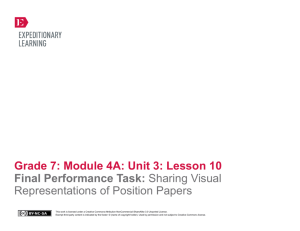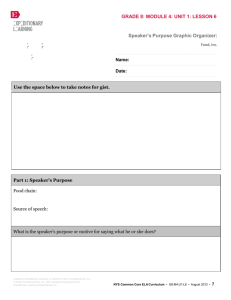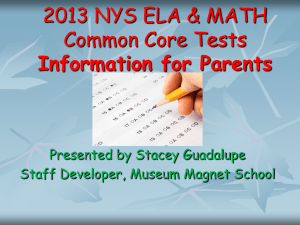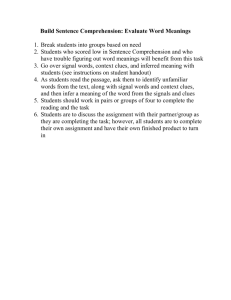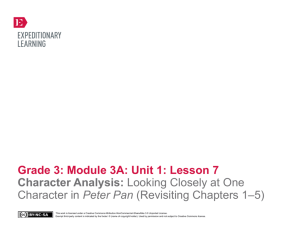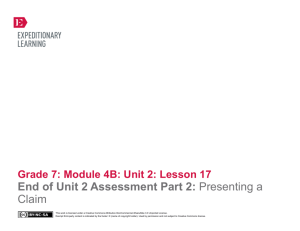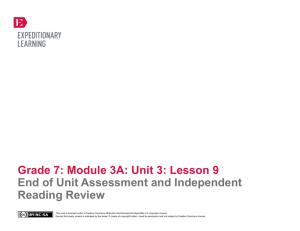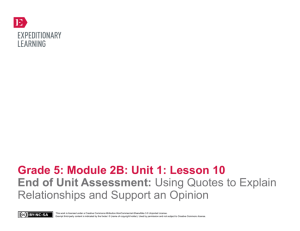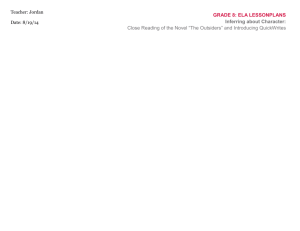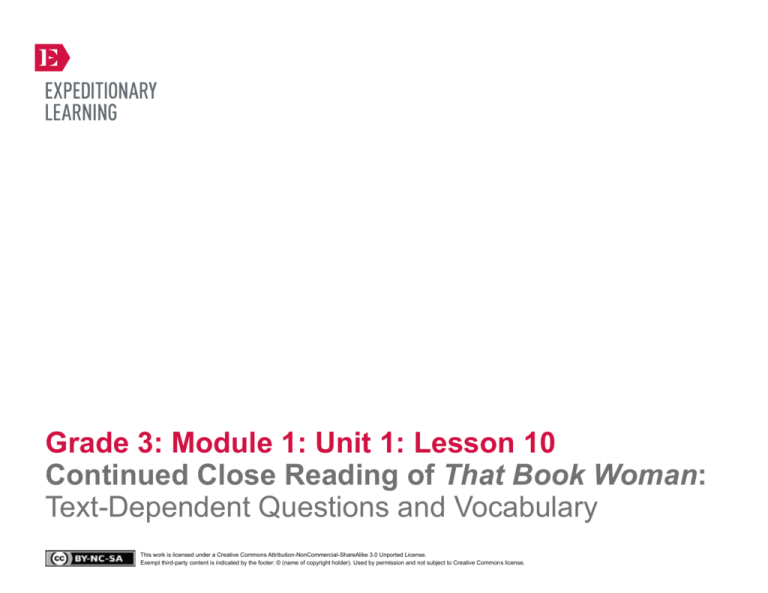
Grade 3: Module 1: Unit 1: Lesson 10
Continued Close Reading of That Book Woman:
Text-Dependent Questions and Vocabulary
This work is licensed under a Creative Commons Attribution-NonCommercial-ShareAlike 3.0 Unported License.
Exempt third-party content is indicated by the footer: © (name of copyright holder). Used by permission and not subject to Creative Commons license.
GRADE 3: MODULE 1: UNIT 1: LESSON 10
Close Reading of That Book Woman:
How Did People Access Books in Rural Areas of the United States?
Long-Term Targets Addressed (Based on NYSP12 ELA CCLS)
I can answer questions using specific details from the text. (RL.3.1)
I can explain what I understand about the topic being discussed. (SL.3.1)
I can use what the sentence says to help me determine what a word or phrase means. (L.3.4)
Supporting Learning Targets
Ongoing Assessment
• I can answer questions using specific details from the That Book Woman.
• Close Read recording forms (completed) for That Book
Woman: Questions from the Text
• I can explain why I chose specific details to answer questions about
the text.
• Vocabulary cards
• I can determine the meaning of new vocabulary using clues in the text around a word.
Agenda
Teaching Notes
1. Opening
• Students will need materials from Lesson 9: excerpts from That Book Woman student copy and their
Close Read recording forms.
A. Engaging the Reader (5 minutes)
2. Work Time
A. Answering Text-Dependent Questions (25 minutes)
• Review: Think-Pair-Share, Helping Students Read Closely, and Quiz-Quiz-Trade Vocabulary strategy
(Appendix 1).
B. Vocabulary (25 minutes)
3. Closing and Assessment
A. Debrief (5 minutes)
4. Homework
A. Complete any unanswered questions on That Book
Woman: Questions from the Text.
Copyright © 2013 by Expeditionary Learning, New York, NY. All Rights Reserved.
NYS Common Core ELA Curriculum • G3:M1:U1:L10 • March 2014 •
1
GRADE 3: MODULE 1: UNIT 1: LESSON 10
Close Reading of That Book Woman:
How Did People Access Books in Rural Areas of the United States?
Lesson Vocabulary
Materials
plowing, dusky, scholar, britches,
passel, yearn
• Close Read recording form anchor chart for That Book Woman (from Lesson 9)
(See also the Teacher Resource in
supporting materials at end of this
lesson for a list of possible words
students can figure out from text; do
not give students these words or the
list, but use this to guide instruction.)
• Illustrations from That Book Woman (pre-selected by teacher)
• Excerpts from That Book Woman (from Lesson 9)
• That Book Woman: Questions from the Text (one per student)
• 8.5" x 11" sheet of white paper
• 3" x 5" index cards (one for each student)
• That Book Woman Vocabulary: Using Context Clues (for Teacher Reference)
Meeting Students’ Needs
Opening
A. Engaging the Reader (5 minutes)
• Gather the students in a circle. Show students several illustrations from That Book Woman by Heather Henson. For
each illustration, ask students to Think-Pair-Share the important details happening in that scene: “Who do you see? What do
you see? What’s an important detail you remember from this part of the story?” Study illustrations for 3 minutes to activate
students’ prior knowledge.
• Unpack the first learning target: “I can answer questions using specific details from the That Book Woman.” Ask students to
turn and talk with a partner, restating this target in their own words.
• Direct students to the Close Read recording form anchor chart for That Book Woman they created during Lesson
9. Remind students that today they will continue rereading, talking, and writing about this challenging text to understand it
even better.
Copyright © 2013 by Expeditionary Learning, New York, NY. All Rights Reserved.
NYS Common Core ELA Curriculum • G3:M1:U1:L10 • March 2014 •
2
GRADE 3: MODULE 1: UNIT 1: LESSON 10
Close Reading of That Book Woman:
How Did People Access Books in Rural Areas of the United States?
Work Time
Meeting Students’ Needs
A. Answering Text-Dependent Questions (25 minutes)
• Remind students that they have already heard or read That Book Woman three times: the read-aloud for enjoyment and to
get the flow of the story, once on their own and with groups to get the gist of it and find unfamiliar vocabulary, and then on
their own and with groups to find and record important details and think about the story’s message or lesson.
• The difficulty of the vocabulary in
That Book Woman may require
greater teacher involvement in the
Vocabulary card and Quiz-QuizTrade activities.
• Ask students to locate the excerpts from That Book Woman that they used in Lesson 9 as well as That Book Woman:
Questions from the Text. Review with students the process they went through to answer questions about Rain School
and Nasreen’s Secret School. First, they read the questions. Then, they read the entire text, keeping those questions in mind.
When they encountered details that could be used as evidence to answer a question, they underlined that section of the text.
Review the word evidence with the class as something we use to prove an idea we have.
• Review how to write answers to questions using a full sentence. The first half of the sentence is pulled directly from the
question. The second half of the sentence is the evidence found in the text. Model this as necessary. Place students in groups,
though they should work on the questions from the text independently. Circulate and support students in finding evidence
and writing in complete sentences.
• After 15 minutes of independent work time, ask students to discuss with their group the evidence they found for each
question as well as the sentences they wrote as answers.
B. Vocabulary (25 minutes)
• Students will now work with the words they circled during their rereading of That Book Woman.
• Gather students in a circle and review the strategy they learned for finding the meaning of unfamiliar words while reading
Rain School. Read the learning target: “I can determine the meaning of new vocabulary using clues in the text around a
word.” Ask students to Think-Pair-Share what this learning target is and what they did with words in Rain School. Share as a
whole group.
• Tell students that That Book Woman is a really hard book, especially because of the dialect. There might have been lots of
words in this story that were difficult for them to understand. Explain the strategy of looking at clues in the text around the
unfamiliar word, and then replacing the word with other words that might mean the same thing.
Copyright © 2013 by Expeditionary Learning, New York, NY. All Rights Reserved.
• The focus of this work is for
students to use context clues in
determining the meaning of
unknown words. In the supporting
materials of this lesson, a list of
words (and their context) lends
itself to this vocabulary strategy.
NYS Common Core ELA Curriculum • G3:M1:U1:L10 • March 2014 •
3
GRADE 3: MODULE 1: UNIT 1: LESSON 10
Close Reading of That Book Woman:
How Did People Access Books in Rural Areas of the United States?
Meeting Students’ Needs
Work Time (continued)
• On one side of an 8.5" x 11" sheet of white paper, write the sentence, “…seeing as how my sister Lark would keep her
nose a-twixt the pages of a book day break to dusky dark.” Circle the word a-twixt. Think aloud the process of using clues in
the sentence: her nose is in a book, she’s reading, where is your nose when you’re reading? Model the process of substituting
other words for the unfamiliar word until one makes sense, for example “in” and “between.”
• Distribute a 3" x 5" index card to each student. Tell them that they will now choose a word from their excerpts from That
Book Woman to repeat this same process. Give students 15 minutes of independent work time to do this with three words.
Remind them that on one side they are to write the whole sentence that the word is in, circling the unfamiliar word. On the
other side, they are to write two possible words that the word they chose might be similar to.
• Gather students back in the circle. Tell them they are going to play a quick game of Quiz-Quiz-Trade. Review the process of
this game by modeling with one student. Remind students that they begin by showing their partner the sentence or phrase
with the unfamiliar word circled. The second person then tries to guess the words on the back of the card. Because students
have multiple cards this time, they should alternate turns.
• Allow students to play Quiz-Quiz-Trade for 10 minutes using all three of their cards.
Meeting Students’ Needs
Closing and Assessment
A. Debrief (5 minutes)
• Gather students back in a circle. Debrief with the question: “What is the most important detail, setting, character, or event
from the story That Book Woman?” Share as a whole group.
Homework
Meeting Students’ Needs
• Complete any unanswered questions on That Book Woman: Questions from the Text.
Copyright © 2013 by Expeditionary Learning, New York, NY. All Rights Reserved.
NYS Common Core ELA Curriculum • G3:M1:U1:L10 • March 2014 •
4
Grade 3: Module 1: Unit 1: Lesson 10
Supporting Materials
This work is licensed under a Creative Commons Attribution-NonCommercial-ShareAlike 3.0 Unported License.
Exempt third-party content is indicated by the footer: © (name of copyright holder). Used by permission and not subject to Creative Commons license.
GRADE 3: MODULE 1: UNIT 1: LESSON 10
That Book Woman:
Questions from the Text
Name:
Date:
1. Why don’t Cal and his family see many people where they live? Use details from the text to support
your answer.
2. According to the text, in what ways does Cal help his father?
3. Why does Cal think the Horse Woman’s horse is brave? Use details from the text to support your
answer.
Copyright © 2013 by Expeditionary Learning, New York, NY. All Rights Reserved.
NYS Common Core ELA Curriculum • G3:M1:U1:L10 • March 2014 •
6
GRADE 3: MODULE 1: UNIT 1: LESSON 10
That Book Woman:
Questions from the Text
4. How does Lark react when Cal wants to learn to read? Use details from the text to support your
answer.
5. What is Cal’s gift to the Book Woman? Use details from text to support your answer.
Copyright © 2013 by Expeditionary Learning, New York, NY. All Rights Reserved.
NYS Common Core ELA Curriculum • G3:M1:U1:L10 • March 2014 •
7
GRADE 3: MODULE 1: UNIT 1: LESSON 10
That Book Woman Vocabulary:
Using Context Clues (Teacher Resource only)
1. sight: “So high we hardly sight a soul—’cept hawks a-winging in the sky.”
2. fetch: “I can fetch the sheep when they take a-wander.”
3. dusky: “…a-twixt the pages of a book daybreak to dusky dark.”
4. fancy: “I do not fancy it one bit when plays Teacher….”
5. scholar: “So now she aims to school us herself. But me, I am no scholar-boy.”
6. britches: “…the rider is no man at all, but a lady wearing britches.”
7. passel: “A passel of books she’s packed clear up the mountainside.”
8. wares: “For if she aims to sell her wares just like the tinker-man …”
9. greenbacks: “…we have no greenbacks here, no shiny coin to spend.”
10. swap: “two weeks to the day she’ll come again to swap these books for more!”
11. spell: “I stand a spell to watch that Book Woman disappear.”
12. yearn: “And all at once I yearn to know what makes that Book Woman risk catching
cold.”
13. nigh: “It’s nigh on spring before that Book Woman can stop to visit a spell.”
Copyright © 2013 by Expeditionary Learning, New York, NY. All Rights Reserved.
NYS Common Core ELA Curriculum • G3:M1:U1:L10 • March 2014 •
8

